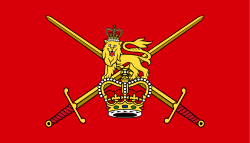Strategic Defence and Security Review (2010)/Army 2020
In 2012, following the Strategic Defence and Security Review of 2010, specific proposals about the make up of the future British Army were announced under the title Army 2020 . These proposals were intended to reduce the size of the army to around 82,000. The Royal Armoured Corps was to be reduced by a total of two regiments, with the 9th/12th Royal Lancers amalgamated with the Queen's Royal Lancers to form a single lancer regiment, the Royal Lancers, and the 1st and 2nd Royal Tank Regiments joined to form a single Royal Tank Regiment.
The Royal Armoured Corps will also see a shift with one third of its regiments operating as armoured regiments with main battle tanks, another third as formation reconnaissance regiments and a final third as light cavalry using Jackal vehicles. [17] Armoured regiments would consist of Type 56 regiments, each with three Sabre Squadrons (comprising 18 Challenger 2 Tanks each) and a command and recce squadron. Armoured Cavalry or formation reconnaissance regiments would also have a command and recce squadron and three Sabre Squadrons; which will initially be equipped with Combat Vehicle Reconnaissance (Tracked), and then with Future Rapid Effect System Scout vehicles. [18] [19] Jackal regiments will be part of the Adaptable Force, comprising three Sabre Squadrons (each with 16 vehicles). These regiments will be paired with a Yeomanry regiment. [19] [20]
The new structure of the Reaction Force will see three armoured regiments, each assigned to a new "Armoured Infantry Brigade", alongside a formation reconnaissance regiment (renamed as "armoured cavalry"), two armoured infantry battalions and a heavy protected mobility battalion. These six regiments will fall operationally under what will become known as the "reaction forces", which will be the army's high readiness force. The remaining three regiments will be located with the remainder of the regular army under what has been term the "adaptable forces", which will provide a pool of resources to back up operations conducted by the "reaction forces".
This new basing plan on 5 March 2013 gave an overview of where the regiments will be based. [21] All RAC regiments will be UK based, with the 1st The Queen's Dragoon Guards moving to Swanton Morley, The Royal Scots Dragoon Guards moving to the Leuchars area, the Queen's Royal Hussars to Tidworth, the Royal Lancers settling in Catterick, the Light Dragoons in Catterick, and the Royal Tank Regiment to Tidworth.
The Army 2020 structure for the Royal Armoured Corps was: [22]


